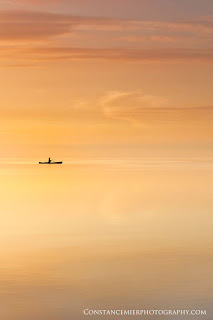With the sun rising behind me, I faced the mangroves to
photograph the usual crowd – great white egret, tricolor heron, little blue heron,
snowy egret, white ibis and yellow-crowned night heron. A day like this was
planned as all of them are - low tide near the time of sunrise or no more than
two hours past. With good morning light, that gave me plenty of time before the
rising water levels compelled the birds to disappear into the mangroves.
After two hours of chasing wading birds from my canoe as the
incoming water slowly rose, I watched them one by one take a final bite and fly
off to some unknown location waiting for the evening low tide to invite them
back for dinner. The flats quickly became void of birds, or so I thought.
By the time I spotted the strange white bird wading along
the shoreline, I had already put away the camera. While Vivian continued
fishing from her canoe, I paddled and floated with no intentions other than to
enjoy the morning on the bay as I usually do when my photography session is finished.
I paddled toward the bird and decided to get the camera back out just for
kicks. The best morning light was long gone, but a white bird wading in the
mangrove reflections is simply irresistible.
Having photographed wading birds on Biscayne Bay for the
past five years, I could identify Florida’s egrets and herons from a distance –
both adult and immature types, as well as lesser common morph versions. So,
when I saw the medium-sized wading bird with white feathers from 300 feet or
more, my first inclination was to go with the typical characters – immature
little blue heron (most likely), snowy egret (possibly) or white ibis (maybe).
But something about this one made me doubt my common knowledge.
When you spend hours, day after day watching and
photographing birds, their behaviors become reliable identifiers. I continued paddling
closer to the lone white bird. It hunted the revealed grasses in earnest and
doing so in a way that was contrary to a snowy egret. By now, I knew it was not
a white ibis that is easily identified by its downcurved red beak. That left me
with an immature little blue heron - but the white bird’s beak was not black.
I was puzzled and very curious. About 150 feet away, I
focused the long lens on the bird and took a shot to get a better look. In
review mode, I zoomed in and gasped. This could not possibly be! The
white-feathered bird had a stocky build, thick neck, and yellow beak. And it
had flaming red eyes. Only a night heron has red eyes in these parts, but
yellow-crowned and black-crowned night herons are not white birds as their
names imply. Nor do they have yellow beaks.
The bird carefully stalked the shallows, catching a crab now
and then with a quick lunge. Everything about it behaved as if it were a
yellow-crowned night heron. But the white feathers – how could this be? What
are the chances of sighting an albino bird in the wild? Wikifacts says the
albinoism in humans has a probability of 1 in 17,000. But what about birds? Never
mind that, I knew this was a rare bird and I was going to photograph it.
The bird paid me no mind as it patiently took advantage of
the conditions that would soon disappear with the rising water levels. At last,
it hopped onto a red mangrove root well above the water and stood nicely framed
by the green leaves. The white bird in its mangrove surroundings is nothing
short of stunning. It was beautiful despite lacking a graceful form we recognize
in other egrets and herons. This was a special bird - I was sure of that by
now. It was alone; but more so, it seemed lonely. I couldn’t put my finger on
it, but it was almost as if the bird knew it was special. I began to worry
about it. It may very well be an albino yellow-crowned night heron; in which
case, those white feathers might be a disadvantage to a bird that is equipped
to hunt at night.
I sent one of my photos of the bird to renowned bird expert
and author, David Sibley. He confirmed it was an albino yellow-crowned night
heron, there could be no other explanation. The Spirit Bird as I came to call
it, lived on Biscayne Bay for at least two years. I know this for a fact
because I photographed it several times. And then, it disappeared. I thought
about it a lot and wondered if it got enough nourishment and found a mate. Or
was it living its short life out in solitude?
Almost two years after my first encounter with the Spirit
Bird, a large-framed print of the rarity hung on a wall for my gallery exhibit
at Biscayne Bay National Park’s Ernest Coe Visitor Center. Accompanying it were
several prints of birds I had photographed on Biscayne Bay. Many of them were
white birds, all of them were common wading birds. Individual birds come and go,
each one replaced by generations of the same. But the Spirit Bird lives on.























































